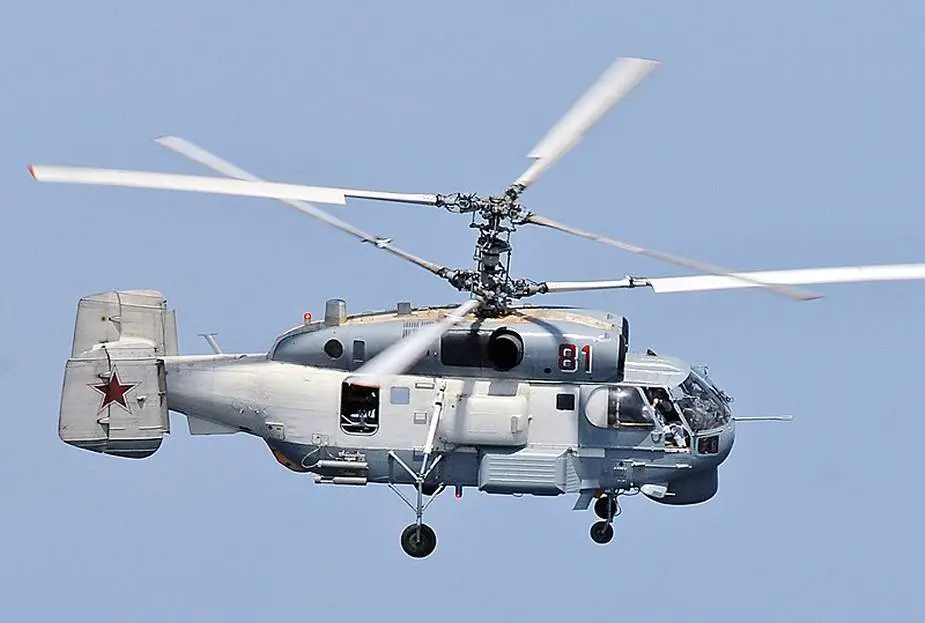The Caspian flotilla will for the first time get its own air unit in post-Soviet time. It will receive Mi-8 and Ka-27 helicopters by the end of 2021. It is done to reinforce the fleet in the Caspian Sea and create a new main base. The helicopters will make the formation exert strategic influence in the whole region, the Izvestia daily writes.
Follow Air Recognition on Google News at this link

A Russian KA-27 Helix helicopter assigned to the Russian destroyer Admiral Vinogradov (DDG 572) flies near the guided-missile cruiser USS Vella Gulf (CG 72) while conducting operations in the Gulf of Aden, February 9, 2009 (Picture source: U.S. Navy/Mass Communications Specialist 2nd Class Jason R. Zalasky)
Russian Defense Ministry sources said the helicopters in the Caspian Sea will mostly engage in search and rescue operations. They can also airlift marines and paratroopers. Beriev Be-200 amphibious aircraft will later join the squadron. The delivery of attack aircraft is also being considered, the sources said.
Caspian flotilla Commander Rear Admiral Sergey Pinchuk disclosed plans to create an air squadron in May 2019, However he did not specify the time. He said Mi-14 helicopters are to be supplied besides Be-200. In late December 2020, Southern Military District Commander Army General Alexander Dvornikov confirmed plans to create naval aviation in the Caspian Sea.
It became possible due to the large-scale construction of a new main base. Defense Minister Sergey Shoigu said new military infrastructure was built in 2020 in Makachkala, as well as berths, the northern and southern malls with a total length of 3 kilometers.
The Defense Ministry said the flotilla command, the headquarters, warships and coastal units had been redeployed from Astrakhan region to the base in Dagestan. Previously, warships had to sail close to a hundred kilometers in the Volga River to the sea from Astrakhan. It was a difficult task in winter and summer shallow waters. The new base allows rapidly reacting to any situation in the region.
The flotilla had no aviation of its own even in Soviet times. The last air units were disbanded in 1948. Since 1960s, the Caspian Sea has been used to train amphibious assault and test attack ground-effect jets. Today the flotilla operates with the aircraft of the Black Sea fleet and the Southern Military District.
“The Soviet Union kept small forces in the Caspian Sea, as there was only Iran nearby which posed no major threat,” former Russian Deputy Foreign Minister Sergey Ordzhonikidze said. “Today Russia maintains good relations with all the countries of the region — Iran, Azerbaijan, Kazakhstan, Turkmenia. However, the region is not stable. Suffice it to recall the latest conflict in Nagorno-Karabakh. Therefore, Russia has to reinforce the Caspian flotilla and regularly hold drills,” he said.
The Caspian flotilla demonstrated its strategic significance in 2015 when it fired at terrorist targets in Syria. “It was a major surprise for the whole world,” Ordzhonikidze said. “Russia showed it was a zone of its influence. If necessary, Caspian warships can support the Black Sea fleet, as the situation is tense in the area and NATO warships and aircraft often appear there,” he said.
The Caspian Sea is an inland sea of five countries. There are major oil deposits in the shelf. They triggered disputes and political conflicts in Soviet time. On August 12, 2018, Russia, Azerbaijan, Iran, Kazakhstan and Turkmenia signed a convention on the Caspian legal status. Negotiations continued since 1996. The bulk of Caspian space and resources remained in common access. The seabed was divided into national sectors. The political document decreased tensions between countries related to the distribution of resources, the Izvestia said.
© Copyright 2021 TASS. All rights reserved. This material may not be published, broadcast, rewritten or redistributed.
















